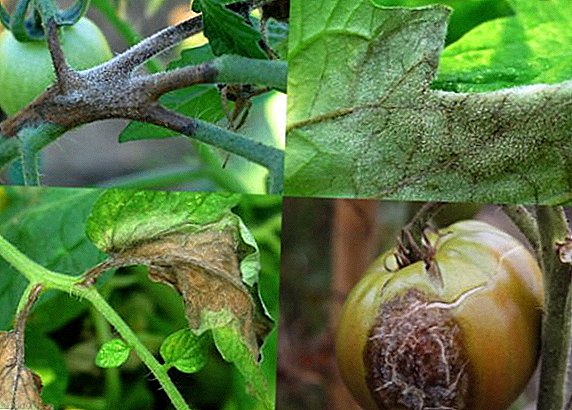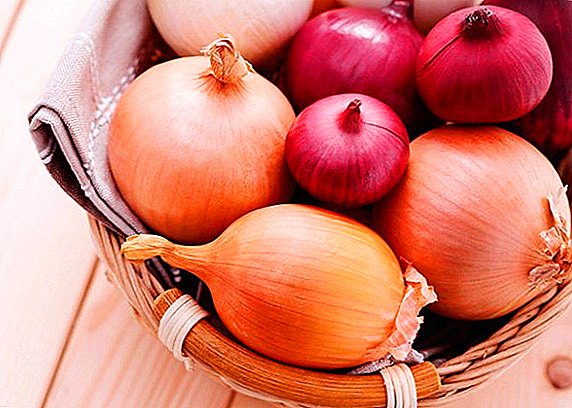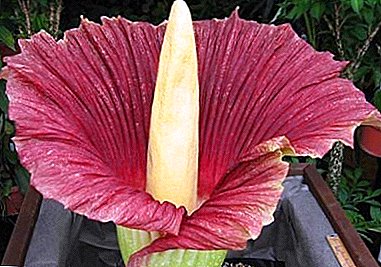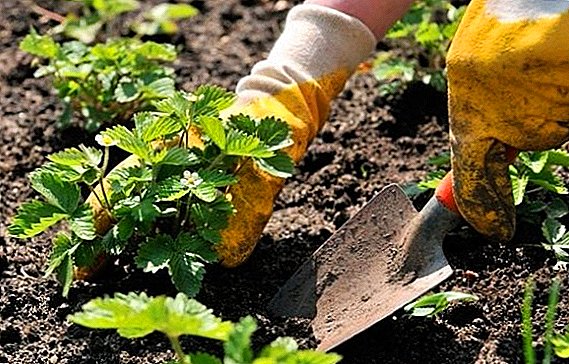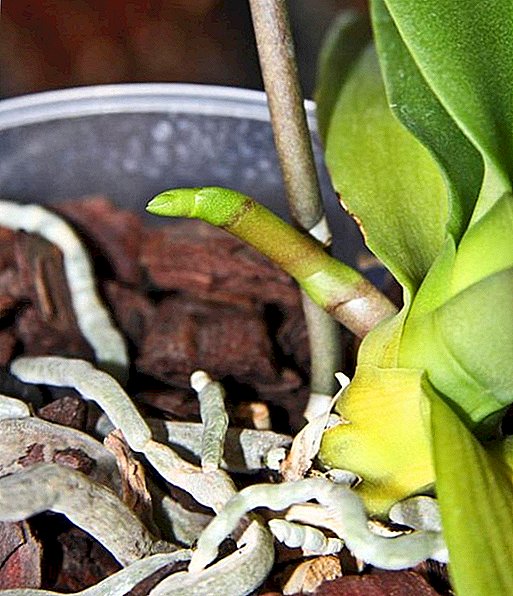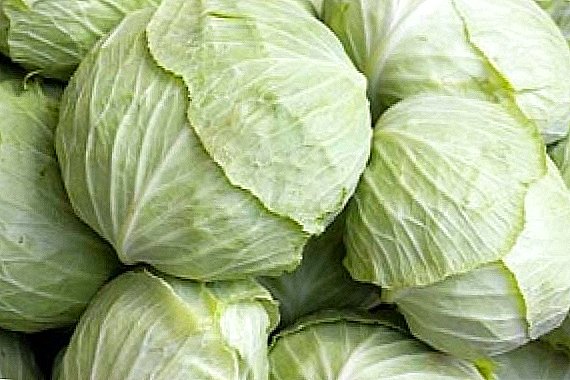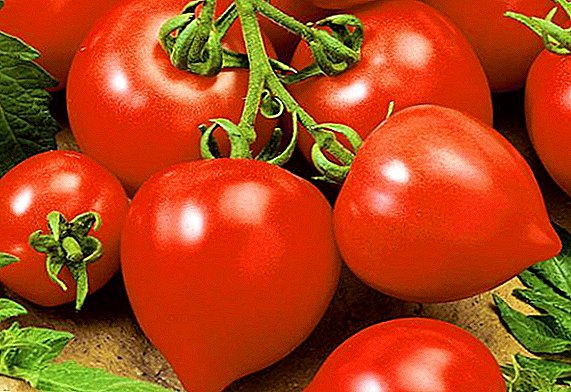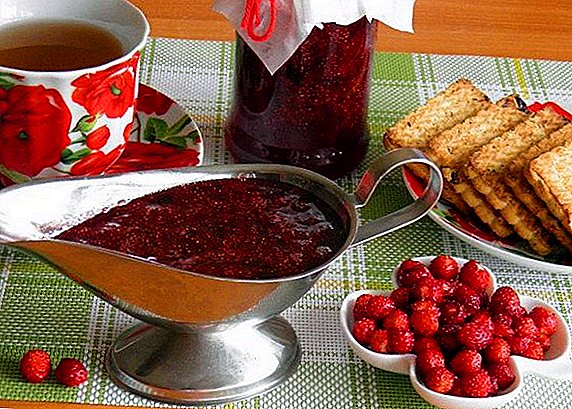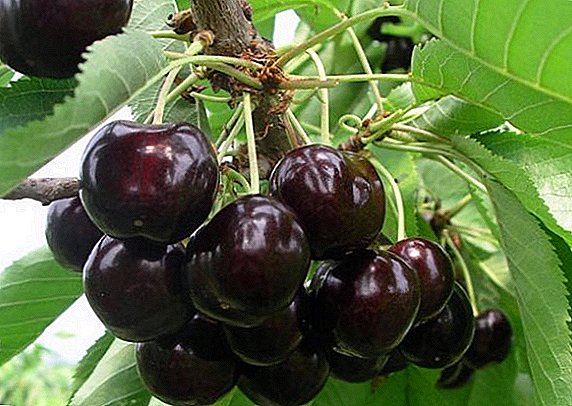 Among the variety of fruit trees should be highlighted cherry. What is just not made from the berries of this tree: compotes, fruit drinks, jams and jams have long become the usual preforms in the kitchen of any hostess. In addition, sweet and juicy cherries are often used to decorate cakes or as a filling for buns, dumplings and other dishes. However, if some varieties of plants are ideal for this purpose, others do not have an attractive taste. In this article we will talk about the cherry called "Black large", which is characterized by its specific features, as well as its other relatives, has its own requirements for planting and subsequent care.
Among the variety of fruit trees should be highlighted cherry. What is just not made from the berries of this tree: compotes, fruit drinks, jams and jams have long become the usual preforms in the kitchen of any hostess. In addition, sweet and juicy cherries are often used to decorate cakes or as a filling for buns, dumplings and other dishes. However, if some varieties of plants are ideal for this purpose, others do not have an attractive taste. In this article we will talk about the cherry called "Black large", which is characterized by its specific features, as well as its other relatives, has its own requirements for planting and subsequent care.
Cherry "Black large": description
Unfortunately, in today's summer cottages cherries are becoming less common. Most summer residents refuse to grow them in favor of sweeter sweet cherry, which is largely due to its simplicity and more attractive appearance. Recently, however, more than 150 new and interesting varieties of cherries have appeared, to which Black Large belongs.
All varieties of cherries are divided by ripening period: early ("Chocolate Girl"), middle-ripening ("Kharitonovskaya", "Vladimirskaya"), late-ripening ("Youth", "Turgenevka").
If we talk about the appearance of this fruit tree, it is relatively low (about 3-4 meters) and stands out with a thick fold-over crown in the shape of a pyramid. The bark of the trunk and twigs is dark gray (greenish on young shoots), slightly rough and does not crack. On long shoots of medium thickness, large internodes are clearly visible.

Cherry "Black large" has rather large oval buds that do not fit to the shoots, and the same large glossy leaves are dark green in color with small teeth along the edges.
Did you know? The Black Large variety was obtained by crossing middle-early sorts of cherries "Consumer black" and "Zhukovskaya", while A.Ya. Voronchikhina - breeder of the Rossosh station.
Impressive sizes differ and tree flowers that grow in inflorescences of 2-3 pieces. They have wide white petals, slightly darkening by the end of flowering.
This variety is also characterized by very large round berries, the mass of which reaches 5-7 grams. They have a tender, juicy, dark red flesh, for which they are valued by gardeners. I must say that this is one of the sweetest varieties, which also has a very pleasant dessert taste.
Important! The stone of the berries is easily separated from the pulp, so you do not have to get too dirty to remove it.
Advantages and disadvantages of cherries "Black large"
Cherries "Black Large" has a whole range of advantages, although its description should not fail to mention the disadvantages. Speaking about the advantages of the variety, it is worth noting the high yield and rapidity, due to which about 15-25 kg of berries can be harvested from one young tree (age 6-8 years).

Moreover, it is very frost resistant option that can withstand temperatures as low as -32 ° -34 ° C without harming the kidneys. By the way, the tree is well tolerated and dry periods, which do not affect the quality of the crop.
The advantages of "Black Large" should be attributed and universality of destination, that is, berries are equally well suited for processing (jam, jams, jam, compotes), and for fresh consumption or freezing (they are quietly stored in a refrigerator for up to two months).
Moreover, this variety is characterized by an early onset of fruiting, which means that you very quickly (at the beginning of July) will be able to enjoy large and juicy berries.
As for the drawbacks of the Black Large cherry, when growing it, you need to be prepared for a “meeting” with various fungal diseases, since in cold and wet weather the tree is often affected by moniliasis or coccomycosis. The life span of a cherry is limited to 15-17 years, and the yield decreases with age, which is also not encouraging.
Read also about the cultivation of cherry felted, bessey, pottery.
How to plant a cherry
Despite the unpretentiousness of the described variety, there are still certain requirements for its planting and care. Therefore, before proceeding to planting a young seedling, be sure to consider the following recommendations.
How to choose a place for planting cherries
The high winter hardiness of the cherry does not mean that it can be planted anywhere. You should be interested only in places well lit, warm and protected from the north winds. Like many other cherries, this variety loves bright sunshine, although it can grow well in partial shade.
Therefore, the southern places of your site are perfect. It is not recommended to plant a tree in places near to the groundwater or in lowlands, where in spring there often occurs a stagnation of melt water.
Black Cherry requirements for soil
In terms of soil composition, Black Large Cherry seedlings do not have high requirementshowever, it is better to plant in light sandy or loamy soil, which is excavated and limeed in advance (400 grams of lime are applied per 1 m²). A week after digging up the soil, organic fertilizers are applied to it (10-15 kg of compost per 1 m²).
Important! You can not make organic at the same time with lime. After liming the area should be at least a week.
How to plant a tree of "Black large" cherry
The ideal time for planting cherries is mid-April, since by this time the earth is already warming up and the buds are still not starting to blossom.. The diameter of the planting pit is calculated based on the size of the rhizome of the seedling and is usually about 80 cm. In depth, the planting bed should reach 50-60 cm.

When digging a pit, the upper fertile layer is removed, mixed with humus (in a 1: 1 ratio), after which 1 kg of ash, 20-25 grams of potassium chloride and 30-40 grams of superphosphate are added to the resulting soil mixture.
When the place is ready, a high peg should be driven into the center of the pit (it should protrude 30-40 cm above the surface of the plot), and pour soil mixture around the peg (10-15 kg of topsoil mixed with 0.4 kg of superphosphate and 0 , 5 kg of ash).
A sapling is installed on this hill of soil, but in such a way that the neck of the tree is 6-7 cm above the surface. After you have straightened the roots of the plant well, you should gradually add the soil, slightly tamping it down so that there are no voids left.
After planting around the seedling at a distance of 25-30 cm, make a hole with a roller of earth on the sides. A bucket of water is poured into it, and as soon as the liquid is well absorbed and the root neck is at the level of the surface of the site, the trunk circle of the tree is mulched with peat, humus or sawdust and the seedling is tied to a peg.
Did you know? "Black large" does not apply to self-fertile varieties of cherries, therefore, is not capable of self-pollination. Considering this, the Turgenevka, Kentskaya, Zhukovskaya, Rossoshanskaya Chernaya and some other varieties are considered good neighbors for such trees.
How to care for seedlings
It cannot be said that, in terms of care, the Black Large variety is very different from many other cherry varieties, however, top dressing, watering and pruning of a plant have their own characteristics. In addition, attention should be paid to the issue of combating various fungal diseases from which this variety suffers quite often.
Watering the "Black large"
Since the cherry is "Black Large" - drought resistant plant (this is indicated in its characteristics), it does not require frequent watering. The first time water is introduced into the soil immediately after the flowering of the cherry (at the same time as feeding it), and the second - with an increase in the size of the berries.
However, if the summer will be very hot and dry, then additional fluid injection will not be superfluous, which means that it will have to be increased to 2-3 times a month. For one watering consumes about 2-3 buckets of water per tree.
After rains, self-moistening of the soil or fertilization in the soil, it is necessary to loosen to a depth of 10-15 cm, and regular mulching will help to retain moisture in the ground.
Important! Loosening the soil around the cherry is carried out at least three times per season, but very carefully so as not to damage the roots of the tree.

Peculiarities of plant nutrition and soil care
Fertilizing into the soil begins with the appearance of the first fruits on the tree. Organic fertilizers (humus or compost) are added to the soil no more than once every two years, while mineral supplements are applied twice a year. Under the autumn digging it is good to add potassium and phosphorus to the ground, and to make nitrogen in the spring. Every five years, the ground is ground lime ash or dolomite flour.
Pruning varieties of cherries "Black Large"
The crown of any cherry must be formed, which provides for periodic pruning of branches and shoots. As for the described variety, it is generally does not tolerate strong thickeningtherefore, each spring branches with shoots over 40 cm should be shortened.
Branches that grow inside the crown are subject to regular removal. In an adult tree, it is necessary to leave no more than 10 main skeletal branches, which will not only make it more accurate and attractive, but will also significantly reduce the risk of moniliasis (provided that the procedure is carried out correctly).
In the process of formative trimming, in order to avoid crone thickening, all unnecessary branches are cut out onto the ring, at the same time laying down new and strong main branches.
Important! If you notice a decay in the growth of the tree, you can spend a light rejuvenating pruning.
Pruning of an annual cherry seedling is usually carried out at a height of 60-80 cm, which allows you to lay 3-4 main branches in the first tier and shtamb a height of 30-50 cm. Next year, the central conductor is shortened 0.6-0.8 m from the highest branches of the first tier. In the second tier leave 2-3 branches, evenly placed around the trunk.
Major diseases and pests of large-fruited cherries
A characteristic feature of the described variety is the tendency to such fungal diseases as moniliosis and coccomycosis, from which the leaves of the tree and sometimes berries suffer.
The first signs of the appearance of coccomicosis are expressed in the formation of small brown dots on the outside of the leaf. Over time, they increase in size, and the lower part of the leaves is covered with a bloom of pink. Affected leaves dry quickly and fall off. Sick berries change shape and turn black.
To protect the cherry from coccomycosis, you can use the following drugs: Skor, Topaz, Topsin-M, Abiga-Peak.
However, even with such symptoms, coccomycosis is not as bad for a tree as moniliosis, which affects all parts of the plant: leaves, branches, shoots and berries. In wet and cold weather, the disease develops very quickly, and expanding brown spots on the leaves (similar to burns) are quickly replaced by lesions on the trunk, shoots and the berries themselves.
Lack of timely treatment will destroy the tree, so at the first symptoms of the disease it is necessary to remove all infected parts, collect fallen leaves, cut off the damaged parts of the bark from the trunk and burn them.

In the fight against moniliosis, spraying with a 3% solution of Bordeaux liquid is used, which is often used for preventive purposes, but at a concentration of 1%. In the war against coccomycosis, spraying trees with copper oxide compounds will be the most effective measure.
It is easy to find them on the current market, but when choosing it is better to give preference to systemic drugs, which have a positive effect not only on the surface of the sheet, but also prevent the formation of spores within it. Despite the fact that their cost is slightly higher, they will benefit more.
Important! Depending on the weather in one season, several treatments may be required.
Do not be afraid to apply chemical compounds at the first manifestations of these diseases, because the affected berries are no less dangerous than modern fungicides.
Black Large: Harvesting
As we have already mentioned, full ripening of cherries of the “Black Large” variety occurs at the beginning of July, and the first crop can be harvested within 3-4 years after planting. If you complied with all the requirements for the care of this tree, then it is during this period that dark, large and juicy berries will be waiting for you.
Like plums, cherries are recommended to be harvested 2-3 days before their full maturity, that is, as soon as you notice that the fruits on the tree have darkened, you can take the stairs and start to pick them. It is most convenient to cut the cherries with brushes near the place of attachment of the stem to the fruit-tree.
In this case, all healthy fruits are placed in a bucket or other container, designed for 4-8 kg, and damaged or ugly berries are collected in a separate container. If you pick cherries without a stem, you will have to use them as soon as possible, since they will let the juice in and will no longer be stored.
Harvesting cherries should be carried out in the morning (as soon as the dew comes down), of course, subject to dry and cool weather.

Observing all agrotechnical requirements, every year you will have enough raw materials for all kinds of conservation and baking, because the Black Large cherry variety responds well to attention to it.


